Design recommendations
Requirement evaluation
Requirement | How tested | Result (for the prototype) | Note | |
Glass frame: The glass frame has to be compliant with the EU standards for Spectacle frames, in particular: The glass frame has to minimize the risk to the wearer The glass frame has to use non-toxic materials The glass frame has to be robust (is measured by the impact of a 22 mm diameter steel ball at 100 Newtons) | The properties of the glass frame can be tested with the Lab testing, which is specified in the EU regulations, which include: Impact resistance testing Chemical testing Biological resistance testing Fall arrest equipment testing |
| The Prototype consists of the pre-bought frame which complies with all the regulations. | |
Extra lens: The product must contain a mechanism that ensures that two different types of lenses can be worn at the same time in just one pair of glasses (customizable). The lenses have to be close to each other (maximum 3mm from each other) to minimize the distortion of the picture. The lens has to be attached and detached without extra tools. The lens must be provided with the antifog properties. The frame has to ensure that both the main lenses and extra lenses can be replaced at a general optician. | The following requirements can be tested with measurements, and user tests. |
| According to the user test and measurements, the prototype complies with the specified requirements. | |
Eyecap: The product must have the ability to completely shield the eyes so that the eyes are protected from the wind or other weather conditions outdoors. The product must contain a mechanism that ensures that the eyecap can be put on and taken off the glasses. The eyecap has to have no gaps between the face and the eyeshield and the glass frame. The material used for the eyecap must be flexible/soft and should fit continuous changes of the eye. | The following requirements can be tested with measurement, and user tests. |
| The material which was used in the eyecap is made out of sponge foam, which has features which are representative of the chosen material. | |
Usability requirements: The mechanism located on the glass frame should clearly communicate its functionality to the user by having a visible signifier for the affordance. The slits on the eyecap should be clearly visible to the user and have a signifier for the affordance. The product should have a case which can effectively and safely store all the components in one place. All the components should be fully detachable to maximize the ease for their cleaning. | The following requirements can be tested with the user tests, desirability test and field research. |
| According to the user test the functionality of the glasses was clear from the design. The point of improvements would be making more obvious holes for the eyecap. | |
Aesthetic Requirement The product should avoid social alienation by looking casual and not too prominent. The frame of the glasses and shape of the lenses must ensure that the glasses can also be used for other purposes instead of people suffering from Graves’ eye disease (broader target group). | Desirability test |
| ||
Co-designer Requirement The aesthetic of the glasses should fit the preferences of the co-designer, so that she feels comfortable interacting with the outside world. The product must be able to last for a long time and must be able to cope with the changing circumstances around the eyes. | Interview with the co-designer, lab testing (for durability) |
| According to the interview, the co-designer was satisfied with the prototype. |
larger target group
The “Design for Specific Users” project proposes a model for designing technologies based on specific user experiences and environments. While the majority of the collaboration has been done with our specific user, the idea is to first concretely look at one use case example and to analyse their contexts and its implications and use this date to then target the design towards a broader group with similar needs. The following text will analyse possible cases and applications where our product may be useful.
Eye dryness is a common issue amongst many people and it is experienced at different levels. For some the environmental factors such as strong winds or dry climate may cause eye dryness and discomfort. However, on the other end of the spectrum there are those who have the problem that their eyes don’t produce enough moisture which can lead to inflammation and damage to the eyes.
According to Boboridis et al. (2023b) Dry eye disease (DED) is a common condition with worldwide estimates in adult populations ranging from 5% to 50% and estimates ranging between 10% and 30% with European countries. Symptoms of dry eyes disease are very similar to what was described by our codesigner. This includes blurry vision, light sensitivity and burning sensation in the eyes (O’Dell & O’Dell, 2022). Moreover, according to a study conducted in the Netherlands, 9.1% of 79,866 participants had DED as measured by the Women’s Health Study and symptoms were particularly prevalent in 20-30 years olds (Vehof et al., 2021).
Contact lens wearer
Contact lens wearers frequently report increased eye dryness compared to non-lens wearers and prevalence of severe symptoms of DED appears up to 4 times more in population-based studies (Stapleton et al., 2017).
Post LASIK eye surgery
According to O’Dell and O’Dell (2022b), dry eyes are a common side effect of laser eye surgery. Moreover, there is a chance of complications after surgery, albeit rare and temporary, these side effects include glare, halos, double vision and vision loss or changes which may occur some weeks or months after the surgery.
Gasketed safety eyewear/ sealed eyewear
With its customizability feature and secure strap, our product allows for a wide range of application and thus it is als a great option for workers who require prescription glasses whilst also being adequately protected against dirt, debris, and splashes to the eyes. Some industries where these can be used include construction, general contracting, metal, lumber and so on.
According to Silliker (2019), there are some challenges with the current design of safety gasket eyewear. When not properly regulated, gasketed eyewear may create hazards due to fogging or discomfort which can lead to improper use of the goggles and some workers may opt to not use them at all. Safety eyewear may also end up being pushed down on the nose by the wearer thus, inadequate protection. Additionally, many comments are related to eye strain, occurring when the eyes become tired and are hurting from intense use. Some complaints include dry or watery eyes, eye soreness, red eyes, difficulty focusing, blurred vision, light sensitivity and headaches.
Clip on sunglasses for prescription wearers
The idea of clip-on sunglasses is definitely something that already exists in the market. They are a much less expensive option than prescription sunglasses and allow you to get sun protection and comfort without removing your normal prescription glasses. However, it is true that some users prefer prescription glasses to clip-ons because they find clip-ons bulky or not attached securely enough for their comfort and they are prone to losing their clip-on attachment. However, our product has the function of making the two lenses attached to the main body of the glasses and appearing as one piece.
Protection against pollution
Researchers sampled the air at subway stations across metropolitan areas in the US and found microscopic particle concentrations that were up to seven times the Environmental Protection Agency’s daily recommended limit (Baggaley, 2021). It is stated that even brief exposures might be hazardous and frequent exposures could lead to an 11% increase in risk of dying from cardiovascular problems.
Protection for the nose and mouth already exist with the N95 face masks but currently there are no proper products for the eyes. Moreover, when wearing masks in the subway (which is what is recommended from the study), glasses would tend to fog up therefore gasketed glasses help to reduce this effect. Although demand for eye protective products for this situation is not something that exists now, it could very well exist soon, thus making this a potential developing/ future target market.
Material choices
Eyecap
The two most common material choices for eye caps on the market are silicone and latex which are both rubbery thermosetting materials.Silicone rubber has high chemical resistance and a wide range of temperature resistance. The popularity of silicone is because it is a man-made, highly durable material that does not retain scents or flavours and it’s 100% non-allergic thus it is often used in medical, food, baby products (Xometry, 2023).However there are some drawbacks being that it is a harder material than latex and thus less comfortable around the eyes in comparison. It is also more expensive material and less resistant to tearing and piercing than latex.
Latex has similar texture and feel as silicone however there are some drawbacks that makes the material a less popular choice for medical and application on baby products. Some people may have an allergic reaction to latex; it is not 100% non-allergic unlike silicone. The material also retains odours, which could be displeasing to some infants and mothers. Moreover, edible fats and direct sunlight cause latex teats to deteriorate more quickly (2022b).
For our eyecap design (Figure 46), silicone will be used mainly due to the fact that it is 100% non-allergic so this is an important requirement for it to be suitable for a large target audience and to be used around sensitive areas such as the eyes.
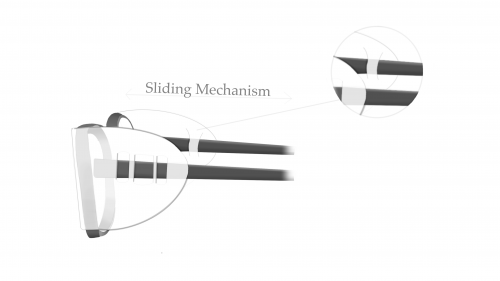
Figure 46
Based on the user testing that we did with our co-designer, she showed a great liking towards the comfort of the foam material of the prototype. Therefore we iterated slightly on the form of the material of the eyecap.
Silicone sponge/foam
The silicone elastomer is expanded as it is heat cured; the expansion process creates compressible air pockets that form the closed cell sponge structure.This expanded form of the closed cell silicone sponge offer some performance benefits of solid silicone in a softer and more compliant form.
Closed cells means that the cells are not interconnecting, therefore water does not go through the material. Generally, silicone sponges have superior mechanical properties and are considered to have a complete closed cell structure and has good water sealing in wash-down applications (Silicone Sponge Rubber, Closed Cell Silicone Sponge | Stockwell Elastomerics, 2022).
Closed cell silicone sponge has a wide operating temperature of -73°C to 260°C which makes it suitable for necessary cleaning and sterilisation processes that users may use. Most bacteria die above 65°C and this material is stable up to 206°C thus sterilisation in boiling water is possible (Silicone Sponge Rubber, Closed Cell Silicone Sponge | Stockwell Elastomerics, 2022). This material is also FDA approved which is needed for food and pharmaceutical packing equipment and product handling.
3M tegaderm is an example of how silicone foam is used in the medical industry (3MTM TegadermTM Silicone Foam Border Dressing, 90647 | 3M United Arab Emirates, n.d.)
. This product is used for post surgery wound dressing, thus it is highly comfortable and ideal for fragile skin. The material also provides a water resistant seal to keep the dressing intact.
The silicone sponge eyecap can be manufactured using compression moulding and finishing can be done in the mould itself. The material forms its own outer layer (‘skin’) which enhances resistance to water absorption and protects from contaminants (Silicone Products Sponge Molded, n.d.).
Frame and flexible component
Most plastic eyeglasses frames are made of cellulose acetate and propionate is the second most common material and is a nylon-based, hypoallergenic plastic (Dr. Boespflug, Dr. Cleverly, and Dr. Denison, 2019b).
For the flexible component, silicone will be used due to its rubber-like properties and flexibility and it can be bonded with the cellulose acetate using glue and primer. With manufacture or eyeglasses, especially branded ones, there are always some level of hand production and usually glueing is done by hand.
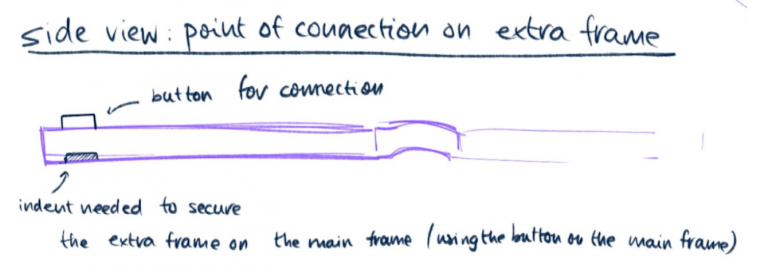
Figure 47
Production methods
The most common manufacturing process for plastic frames is die cutting (How Eyeglass Frame Is Made – Material, Manufacture, Making, History, Used, Dimensions, Industry, Machine, History, n.d.).
For this process creating indents and holes are possible using a punch, however it must be that the maximum thickness anywhere on the product will be the thickness of the raw material sheet. Some design considerations need to be done with protrusions for the buttons.
One option is to use a brass component and it is glued on to the frame as buttons, and the same would be done with the hinge for the arms. Another option is to make the button as part of the hinge, and let it extend all the way through the frame out the front. This way it is one less part to the bill of materials.
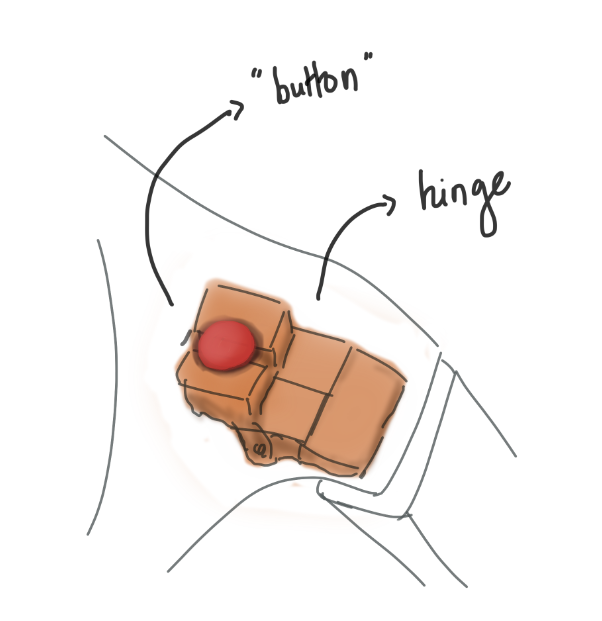
Figure 48. Make the button that sticks out the front part of the arm mechanism and just let it protrude all the way through the frame until it sticks out the front.
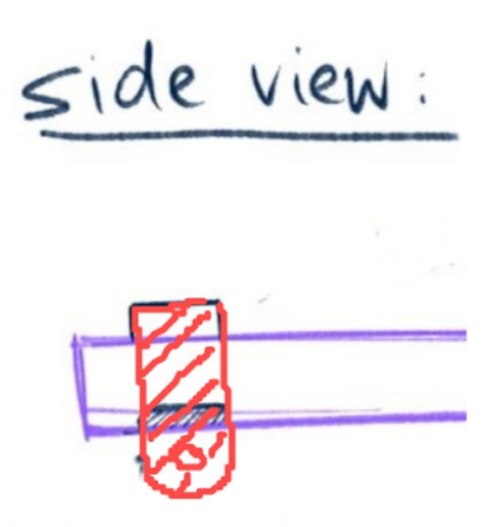
Figure 49
And the corresponding hole for that part can be stamped out. Another thing to consider for protrusions is the alignment with its counterparts. For this, a boss can be used as a positioning aid.
Replaceable sponge material
Antimicrobial Polyhexamethylene Biguanide (PHMB) is a synthetic compound which has a broad spectrum of activity against bacteria and fungi thus they are found often in medical applications (Foams – Advanced Medical Solutions Group Plc, 2018c). This foam material allows absorption of liquid into the microporous structure and the polyurethane backing membrane allows transmission as moisture vapour. The polyurethane backing membrane provides a high Moisture Vapour Transmission Rate (MVTR) making it an ideal material for the sponge of the moisture chamber.
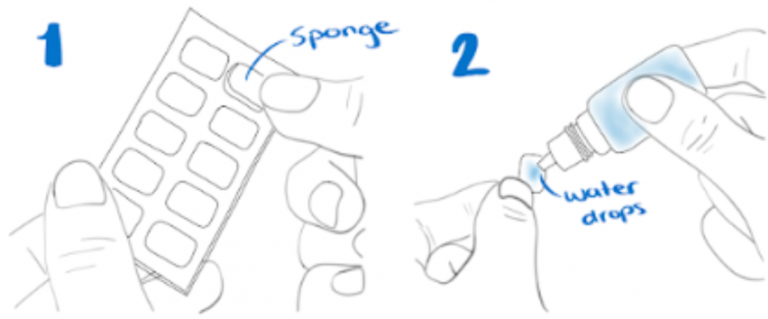
Figure 50
Possible additives and additional features
Antimicrobial protection
Silver based antimicrobial technology, looks at the increasing use of antimicrobial protection in plastics(BioCote Ltd, 2022). Silver damages bacterial cell membranes and can be mixed into the polymer melt so that it is naturally antibacterial.
Anti Fog coating
In gasketed eyewear designs, ventilation holes are the common solution to reduce fogging of the lenses. However, this is not an ideal for the specific target group of the codesigner and users suffering from DED thus another option is to use hydrophobic anti fog coating which are materials which cannot have water in contact with it thus it has properties to reduce fogging (3MTM Safety Eyewear and Splash Goggle With ScotchgardTM Anti-Fog Coating., n.d.).
